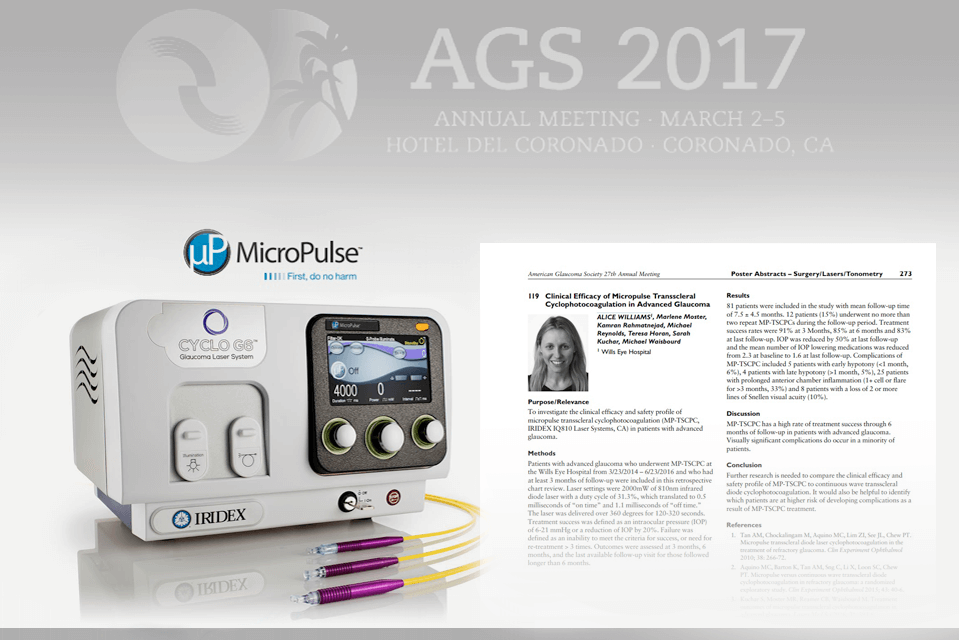
MicroPulse® P3 Glaucoma Device (MP3) Innovative Cyclophotocoagulation with MicroPulse Technology Powered by the NEW CYCLO G6™ Glaucoma Laser System | Source: iridex.com
Advanced glaucoma is a particularly tricky condition to treat. If not aggressively controlled, vision will be lost, sometimes over a very short period of time. However, all surgical treatments also carry a small risk of loss of vision immediately or shortly after surgery. Add to this the fact that the more advanced the glaucoma the more likely someone will have a severe, permanent loss of vision after surgery. What is a patient to do?
Traditional Continuous Wave Cyclophotocoagulation has commonly been used to treat advanced glaucoma in eyes with poor vision. The risks of this procedure were simply too high to use on eyes with remaining functional vision. A newer version of cyclophotocoagulation, Micropulse P3 Cyclophotocoagulation (MP3), appears to be much safer yet provide a similar intraocular pressure (IOP) reduction. Could this be an appropriate treatment for advanced glaucoma?
Dr. Alice Williams and colleagues (Wills Eye Hospital Glaucoma Research Center) addressed this question at the recent American Glaucoma Society (AGS) 2017 Annual Meeting in San Diego, CA (March 2-5) in a poster entitled, “Micropulse Transscleral Cyclophotocoagulation in Advanced Glaucoma”.
The study team evaluated the charts of 79 patients with advanced glaucoma who underwent MP3 and were followed for at least 3 months. Average pre-op vision was 20/200 (ranged from 20/20 to complete blindness). Average IOP prior to surgery was 32mmHg. Three months after having this glaucoma treatment 85% had either an IOP between 6-21mmHg or a 20% reduction in IOP. Of those followed to six months 78% still met this definition of success. Average IOP after surgery at the 3 and six month marks were 14.4mmHg and 15.8mmHg, respectively. Medication use dropped from 2.3 medications to 1.6 (on average).
The most common complication was prolonged inflammation (26%). The most serious complication was loss of vision (16%). Causes of vision loss included macular edema (swelling), corneal edema, cataract, hypotony maculopathy, and phthisis (blind, shrunken eye). Three patients had loss of vision that could not be explained.
In summary, Micropulse Cyclophotocoagulation (MP3) appears to be an effective treatment of advanced glaucoma. However, a higher rate of vision loss was observed than has been seen in other studies of MP3. It should be noted, as mentioned earlier, that this risk tends to be higher in those with advanced glaucoma. Whether the risk of vision loss after MP3 is, indeed, lower than what would be expected with trabeculectomy or glaucoma drainage device implantation would be a worthy topic for a future study.
Need Help with Your Glaucoma?
Learn more about this blinding disease. Know your treatment options. Talk to a board-certified Ophthalmologist who is an expert in the treatment of glaucoma and cataract.
Related Articles:
- One-Year Results of Micropulse Trans-scleral Cyclophotocoagulation – Yale Study
- Micropulse Laser Trans-Scleral Cyclophotocoagulation – The Tulane Study Group Results
- How Does Micropulse® P3 Cyclophotocoagulation Work?
- Micropulse® Cyclophotocoagulation (MP3) Glaucoma Treatment at Earlier Stages of Glaucoma
- MicroPulse® P3 “Cyclophotocoagulation” – A Burst of Good News for those with Glaucoma

David Richardson, MD
Medical Director, San Marino Eye
David Richardson, M.D. is recognized as one of the top cataract and glaucoma surgeons in the US and is among an elite group of glaucoma surgeons in the country performing the highly specialized canaloplasty procedure. Morever, Dr. Richardson is one of only a few surgeons in the greater Los Angeles area that performs MicroPulse P3™ "Cyclophotocoagulation" (MP3) glaucoma laser surgery. Dr. Richardson graduated Magna Cum Laude from the University of Southern California and earned his Medical Degree from Harvard Medical School. He completed his ophthalmology residency at the LAC+USC Medical Center/ Doheny Eye Institute. Dr. Richardson is also an Ambassador of Glaucoma Research Foundation.


